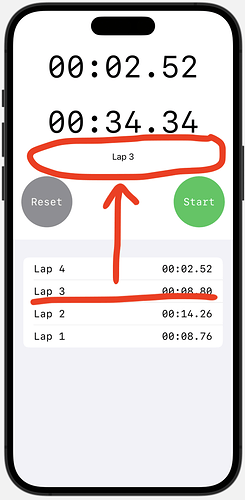Bonjour,
Sur la base d’un chronomètre « récupéré » sur GitHub je souhaite un champ où s’affiche le dernier LAP enregistré, LAP1 puis LAP2…ce que je souhaite c’est le chronomètre, le numéro du LAP c’est OK.
Cette donnée existe dans te tableau créée par le code mais je n’arrive pas à la récupérer.
Merci d’avance
import SwiftUI
struct ContentView: View {
let timer = Timer.publish(every: 0.01, on: .main, in: .common).autoconnect()
@State var minutes = 0
@State var seconds = 0
@State var centiseconds = 0
@State var running = false
@State var lapTimes : [LapTime] = []
@State var lapCount = 1
@State var lapMinutes = 0
@State var lapSeconds = 0
@State var lapCentiseconds = 0
var body: some View {
VStack{
Text(getTimeString(cS: self.lapCentiseconds, sS: self.lapSeconds, mS: self.lapMinutes))
.font(.system(size: 60, design: .monospaced))
.frame(width: 300.0, height: 100.0)
.onReceive(timer){_ in
if(self.running){
self.timerCalcs()
}
}
Text(getTimeString(cS: self.centiseconds, sS: self.seconds, mS: self.minutes))
.font(.system(size: 60, design: .monospaced))
.frame(width: 300.0, height: 100.0)
.onReceive(timer){_ in
if(self.running){
self.timerCalcs()
}
}
Text("Lap \(lapCount - 1)")
// Text(lapTimes[0].time)
HStack{
Button(action: {
if(!self.running){
self.minutes = 0
self.seconds = 0
self.centiseconds = 0
self.lapTimes = []
self.lapMinutes = 0
self.lapSeconds = 0
self.lapCentiseconds = 0
self.lapCount = 1
}
else{
self.lapTimes.append(LapTime(n: self.lapCount, t: self.getTimeString(cS: self.lapCentiseconds, sS: self.lapSeconds, mS: self.lapMinutes)))
self.lapCount += 1
self.lapMinutes = 0
self.lapSeconds = 0
self.lapCentiseconds = 0
}
}) {
ZStack{
Circle().fill(Color.gray).frame(width: 100, height: 100)
self.running ? Text("Lap").foregroundColor(Color.white).font(.system(size: 20, design: .monospaced)) : Text("Reset").foregroundColor(Color.white).font(.system(size: 20, design: .monospaced))
}
}
Spacer()
Button(action: {
self.running = !self.running
}) {
ZStack{
Circle().fill(self.running ? Color.red : Color.green).frame(width: 100, height: 100).font(.system(size: 20, design: .monospaced))
self.running ? Text("Stop").foregroundColor(Color.white).font(.system(size: 20, design: .monospaced)) : Text("Start").foregroundColor(Color.white).font(.system(size: 20, design: .monospaced))
}
}
}.padding()
List{
LapTime(n: self.lapCount, t: self.getTimeString(cS: self.lapCentiseconds, sS: self.lapSeconds, mS: self.lapMinutes))
ForEach(self.lapTimes.reversed()) { time in
time
}
}
}
}
func timerCalcs(){
if(self.centiseconds < 99){
self.centiseconds += 1
}
else{
self.centiseconds = 0
if(self.seconds < 59){
self.seconds += 1
}
else{
self.seconds = 0
self.minutes += 1
}
}
if(self.lapCentiseconds < 99){
self.lapCentiseconds += 1
}
else{
self.lapCentiseconds = 0
if(self.lapSeconds < 59){
self.lapSeconds += 1
}
else{
self.lapSeconds = 0
self.lapMinutes += 1
}
}
}
func getTimeString(cS: Int, sS : Int, mS: Int) -> String{
var centiString = String(cS)
var secString = String(sS)
var minString = String(mS)
if(cS<10){
centiString = "0\(cS)"
}
if(sS<10){
secString = "0\(sS)"
}
if(mS<10){
minString = "0\(mS)"
}
return "\(minString):\(secString).\(centiString)"
}
}
struct LapTime : View, Identifiable{
let id = UUID()
let num : Int
let time : String
var body : some View{
HStack{
Text("Lap \(num)").font(.system(size: 20, design: .monospaced))
Spacer()
Text(time).font(.system(size: 20, design: .monospaced))
}
}
init(n : Int, t : String){
num = n
time = t
}
}
struct ContentView_Previews: PreviewProvider {
static var previews: some View {
ContentView()
}
}
